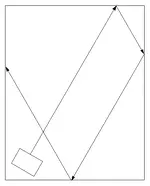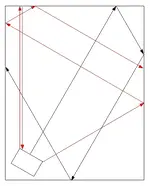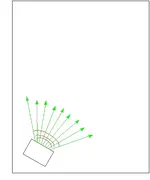Yeah, start drawing the reflections on those lines

And at points where the acoustical energy crosses each other, you have a potential point (of collision) which many things could happen. The acoustical wave could change direction, a primary wave could overpower the colliding reflection, you could have a reduction in volume (db) or an increase in volume, depending on many factors. These are the factors we try to use as a guide for acoustical treatments. Here is some math:
V (sound in air) = 331.4 + .6T meters per second.
T = temperature celcius.
So, after doing all your inaccurate, approximative wave drawings like I have, change the temperature, and its all "way off" anyway. At 70F, sound travels at approximately 1129.5202682997958 feet per second.

At 40F, sound travels at approximately 1096.1650627004955 feet per second. At 90F, sound travels at approximately 1151.7570720326625 feet per second.
have a headache yet?
Reflections are how your brain uses the information from your two ears (stereo image) to near-instantly determine your position within a room. Consider this experiment.
I, instruct you Rick, to stand blind folded on a moving dolly. I and Knightfly move you on this dolly around a rectangular basement so slowly, you cannot feel what direction you moved, to different positions within the room. Knightfly will move to another part of the room, and clap his hands once. You, from what you hear only, would be able to guestimate the angle from your nose that the original clap occured, thus identifying approximately his position, from you, within the room. In addition, if you really were to think about it while standing on the dolly, you'd also be able to determine where in the room you are, and how close to which wall you are, north, south, east, west. Thank you Knightfly for your participation.

How would you know this? Locating Knightfly is easy... because the primary source (the actual clap) is going to be louder than any reflection. So you could effectively point at him within a very small margin of error, even though you cannot see him.
Your ears also pick up reflection waves, which is part of how our brains work, and based on the reflections entering your ear canals, you can determine your distance from any of the four walls by comparing reflections. You don't have to actually do this comparison, your brain does it automatically. Your spongy processor is taking into consideration timing differences, as well as amplitude differences to make these determinations. So you can in fact, blindfolded on a dolly, not only point at Knightfly, you can also say "north wall", or "South East corner", etc, with a high degree of accuracy.
Now, when you treat a room, and have fairly significant amplitude generating sound sources (i.e. studio speakers), this changes, because its NOT an environment your brain was designed to decipher. By changing the reflective, and absorbtion properties of the room, you can easily confuse the brain as to location within the room, even though more than likely you could pick out the initial sound source still. The "deadder" the room (meaning more absorbtion), the less likely it is you can define your position within the space, using only your hearing.
Because of the massive energy bass frequencies carry just by the very nature of it, if we were to repeat these tests with a subwoofer in the room, pumping in say, oh, 1200W RMS, you'd never pluck your position out of the room blindfolded, because the energy (pressure waves) in the room would be so great your brain would be confused. Bass is non-directional, because it goes everywhere, and while it does reflect and does bounce all over, having more energy than the air can consistantly transmit introduces all sorts of acoustical problems.
Another anomily of the ear-brain system is the automatic ability to "self-filter" monotonous noises. If you have several consistant, noisy devices in the room, your brain will filter those fundimental frequencies and associated harmonics, out of your perception after a while. Same principle that noise-cancelling headphones use BTW. Anyway, slap a window air conditioner in your room on the left side, and after a period of time you won't hear it the same way any longer. But, because your brain is filtering out that noise (mostly the harmonics actually), its also filtering out acoustical information unrelated to the air conditioner, acoustical information generated from your studio speakers.
take all that into consideration in your math, please

Anyway, all this data, as perceived by the brain, is what gives us as musicians, engineers, hobbiests the ability to "decide" what a room feels like. Is it "dead", is it "warm", is it "smooth and creamy". I had a pro studio years ago, and my partner could be blindfolded, walk into any room, and based on normal speech in that room, tell you what is on the floor, walls and ceilings if the room was "medium sized". Not only could he say "hardwood" if there was, but he could tell you "maple" or "birch" or "oak". Tell me that is not impressive. This is an individual who's very aware of his surroundings, moreso than the average guy.
So, have a headache yet?
A lot of what "sounds good" of course is subjective, but one thing to keep in mind is the acoustical power generated within a space. We often don't touch on that here because it's really difficult to calculate and comprehend, but it does matter greatly.
In a 9' x 11' room, a pair of Radio Shack minimus-7's with a small 8" sub will sound pretty good at reasonable levels, even without a tremendous amount of acoustical treatments. Replace those with a double-15" woofer, 5 speaker setup (per side), drive that with 1000W RMS of crown amplifier, and that room is going to become painful, and the acoustical information your brain picks up is going to be very garbled. You've overpowered the room.
This is another reason why larger rooms sound better than smaller rooms to the majority of people, because its more difficult for a sax player to overpower (acoustically) a room that's 20'x30 with a 14-18' vaulted ceiling. And if you mic closely, you can record that musician fairly dry.
Acoustical power is also the reason why I believe gents like John Sayers recommend using the length of the room rather than the width, so there is more air behind you, rather than in front of you. It gives the primary acoustical energy from your speakers a place to go. As sound travels through air, it loses its amplitude because objects at rest, want to stay at rest, and will resist acoustical energy. Basic physics. And the objects that want to stay at rest in this case are air molecules.
Now, lets discuss the listening position. You mentioned that some "ekspurts" suggest mixing at the back of the room, therefore eliminating the perception of reflections because you're so close to the back wall. In theory, this sounds reasonable. I tried it in a bedroom studio when I lived in connecticut, and I didn't like how it sounded at all. Why? I dunno. I can't really explain why, but it didn't sound too good. It's very possible (and likely, I guess) that because I've owned a few pro studios, and set things up "the other way", I'm used to having air behind me, not in front of me, and out of "brain habit" I wouldn't like it no matter what. Conditioning maybe?

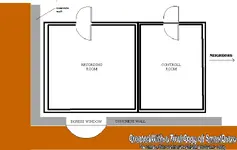
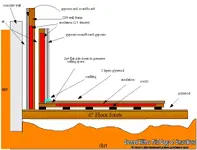
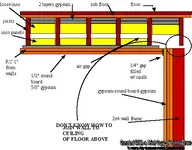


 (no fun!!) But this ALL DEPENDS on what the structural engineer AND what the codes require.
(no fun!!) But this ALL DEPENDS on what the structural engineer AND what the codes require. You mentioned the STEEL BEAM in the center, probably running the LONG dimension, but not how or what supports the joists AT THE WALL. AND if there are piers between the steel beam and the wall, which I doubt, but you never know. So, as to your PROPOSED "floating floor", the SECTION drawing looks ok, however, this still depends on the codes and engineers ok. He MUST know exactly what you are planning, and what exists, which I'm sure he will look at. But let me add something here. Some information has come to light in the last week, that you should read.
You mentioned the STEEL BEAM in the center, probably running the LONG dimension, but not how or what supports the joists AT THE WALL. AND if there are piers between the steel beam and the wall, which I doubt, but you never know. So, as to your PROPOSED "floating floor", the SECTION drawing looks ok, however, this still depends on the codes and engineers ok. He MUST know exactly what you are planning, and what exists, which I'm sure he will look at. But let me add something here. Some information has come to light in the last week, that you should read.  . Because of this compression, shape, spacing, density, "springyness", dampening and other factors must be taken into consideration when specifying these pucks. Because so many people here and elsewhere have built floating floors using "net fact" specification of these "resiliant pads", it has almost become a cliche solution for decoupling floors. But now, because of this new information, I am hesitant to continue offering my opinion regarding how to do this, as I believe it is MUCH more difficult to correctly calculate this stuff than I previously imagined.
. Because of this compression, shape, spacing, density, "springyness", dampening and other factors must be taken into consideration when specifying these pucks. Because so many people here and elsewhere have built floating floors using "net fact" specification of these "resiliant pads", it has almost become a cliche solution for decoupling floors. But now, because of this new information, I am hesitant to continue offering my opinion regarding how to do this, as I believe it is MUCH more difficult to correctly calculate this stuff than I previously imagined. But I DO know this. You ALREADY have a floor that is a DIAPHRAM, which means, it will ALSO affect the NEW structure, as it too has a resonant frequency, AND an airgap which MAY or MAY NOT, ALSO have a resonant frequency IF SEALED. SOooooooooo........
But I DO know this. You ALREADY have a floor that is a DIAPHRAM, which means, it will ALSO affect the NEW structure, as it too has a resonant frequency, AND an airgap which MAY or MAY NOT, ALSO have a resonant frequency IF SEALED. SOooooooooo........
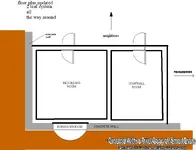
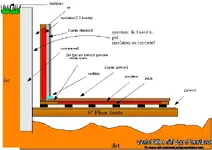
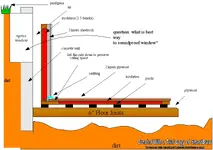
 it has a resonance much lower than your existing floor could EVER attain, no matter how much you add to it. That is the problem. Membranes resonate BACK into the space, and can actually make the situation WORSE. At least from my understanding.
it has a resonance much lower than your existing floor could EVER attain, no matter how much you add to it. That is the problem. Membranes resonate BACK into the space, and can actually make the situation WORSE. At least from my understanding. 